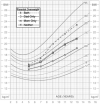Parent overweight predicts daughters' increase in BMI and disinhibited overeating from 5 to 13 years
- PMID: 17557992
- PMCID: PMC2562317
- DOI: 10.1038/oby.2007.183
Parent overweight predicts daughters' increase in BMI and disinhibited overeating from 5 to 13 years
Abstract
Objective: To assess whether parental overweight status and disinhibited overeating are predictive of daughters' accelerated weight gain and disinhibited overeating.
Research methods and procedures: Participants were part of a longitudinal study of girls (N = 197) and their parents. Measured height and weight were used to calculate BMI [weight (kilograms)/height (meters)(2)]. Parents' disinhibited eating behavior was assessed using the Eating Inventory. Girls' disinhibited eating was assessed using a behavioral protocol to measure eating in the absence of hunger. Girls were classified based on parental overweight at study entry into four groups: neither, mother only, father only, or both parents overweight.
Results: Girls with both parents overweight had the most rapid increases in BMI from 5 to 13 years of age; BMI increased most slowly among the neither parent overweight group, with intermediate increases in BMI among mother only and father only overweight groups. Daughters with both parents overweight at study entry were eight times more likely to be overweight at age 13, controlling for daughters' weight at age 5. Girls with both parents overweight had higher levels of disinhibited eating across all ages than all other groups. Although girls in all parental weight status groups showed increases in disinhibited eating over time, girls with both parents overweight had larger increases in disinhibited eating over time compared with all other groups.
Discussion: Girls growing up in families differing in parental overweight had divergent developmental trajectories for BMI and disinhibited overeating. Findings reveal the need to focus prevention efforts on overweight parents of young children.
Figures


Similar articles
-
Like mother, like daughter: familial patterns of overweight are mediated by mothers' dietary disinhibition.Am J Clin Nutr. 1999 Apr;69(4):608-13. doi: 10.1093/ajcn/69.4.608. Am J Clin Nutr. 1999. PMID: 10197561 Clinical Trial.
-
Influence of parents' eating behaviors and child feeding practices on children's weight status.Obesity (Silver Spring). 2006 Mar;14(3):431-9. doi: 10.1038/oby.2006.57. Obesity (Silver Spring). 2006. PMID: 16648614
-
The complicated relationship among parent and child disinhibited eating behaviors.Appetite. 2022 Apr 1;171:105923. doi: 10.1016/j.appet.2022.105923. Epub 2022 Jan 11. Appetite. 2022. PMID: 35026372 Free PMC article.
-
Parental encouragement of dieting promotes daughters' early dieting.Appetite. 2014 Sep;80:190-6. doi: 10.1016/j.appet.2014.05.016. Epub 2014 May 20. Appetite. 2014. PMID: 24858835 Free PMC article.
-
Family environmental factors influencing the developing behavioral controls of food intake and childhood overweight.Pediatr Clin North Am. 2001 Aug;48(4):893-907. doi: 10.1016/s0031-3955(05)70347-3. Pediatr Clin North Am. 2001. PMID: 11494642 Review.
Cited by
-
Eating in the absence of hunger in adolescents: intake after a large-array meal compared with that after a standardized meal.Am J Clin Nutr. 2010 Oct;92(4):697-703. doi: 10.3945/ajcn.2010.29812. Epub 2010 Aug 18. Am J Clin Nutr. 2010. PMID: 20720255 Free PMC article. Clinical Trial.
-
Eating in the absence of hunger: Stability over time and associations with eating behaviours and body composition in children.Physiol Behav. 2018 Aug 1;192:82-89. doi: 10.1016/j.physbeh.2018.03.033. Epub 2018 Mar 30. Physiol Behav. 2018. PMID: 29609000 Free PMC article. Clinical Trial.
-
Understanding eating in the absence of hunger among young children: a systematic review of existing studies.Appetite. 2015 Feb;85:36-47. doi: 10.1016/j.appet.2014.10.032. Epub 2014 Nov 7. Appetite. 2015. PMID: 25450900 Free PMC article.
-
Mindfulness-based group intervention in adolescents at-risk for excess weight gain: A randomized controlled pilot study.Appetite. 2019 Sep 1;140:213-222. doi: 10.1016/j.appet.2019.05.022. Epub 2019 May 18. Appetite. 2019. PMID: 31112737 Free PMC article. Clinical Trial.
-
Developmental perspectives on nutrition and obesity from gestation to adolescence.Prev Chronic Dis. 2009 Jul;6(3):A94. Epub 2009 Jun 15. Prev Chronic Dis. 2009. PMID: 19527595 Free PMC article.
References
-
- Patrick H, Nicklas TA. A review of family and social determinants of children’s eating patterns and diet quality. J Am Coll Nutr. 2005;24:83–92. - PubMed
-
- Cullen KW, Lara KM, de Moor C. Familial concordance of dietary fat practices and intake. Family Commun Health. 2002;25:65–75. - PubMed
-
- Wardle J, Guthrie C, Sanderson S, Birch L, Plomin R. Food and activity preferences in children of lean and obese parents. Int J Obes Relat Metab Disord. 2001;25:971–7. - PubMed
-
- Trost SG, Kerr LM, Ward DS, Pate RR. Physical activity and determinants of physical activity in obese and non-obese children. Int J Obes Relat Metab Disord. 2001;25:822–9. - PubMed
Publication types
MeSH terms
Grants and funding
LinkOut - more resources
Full Text Sources

